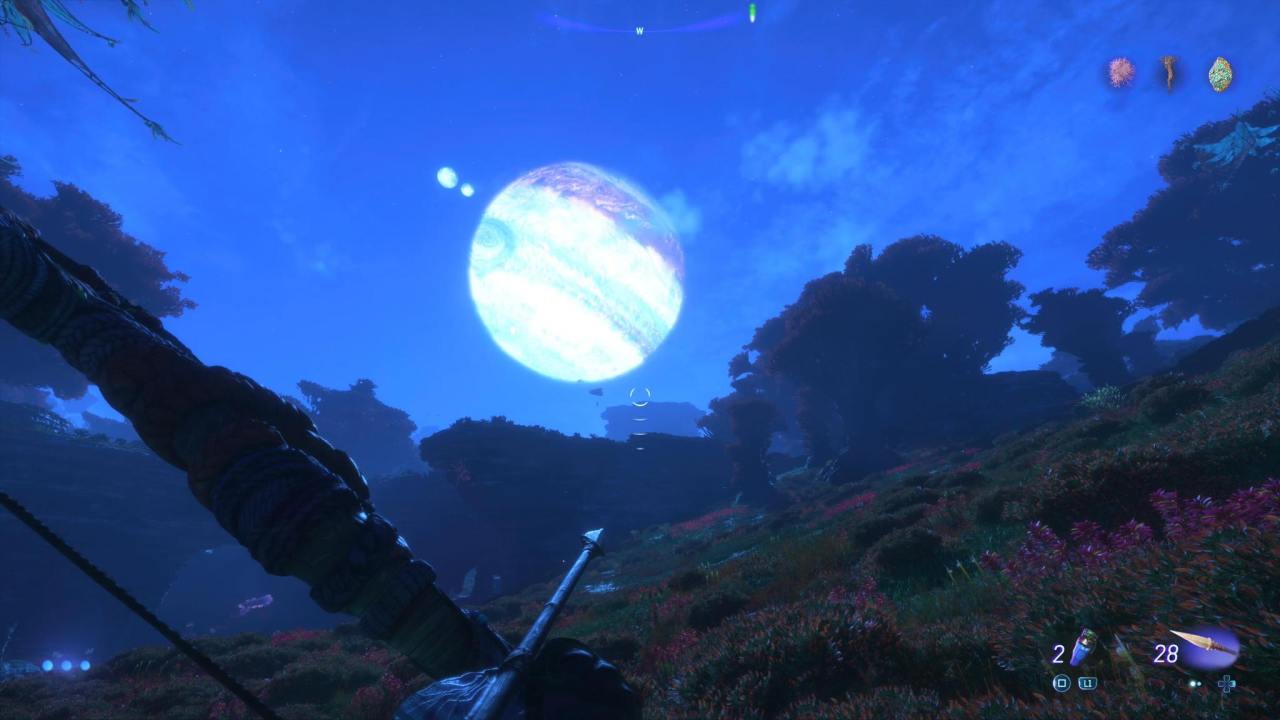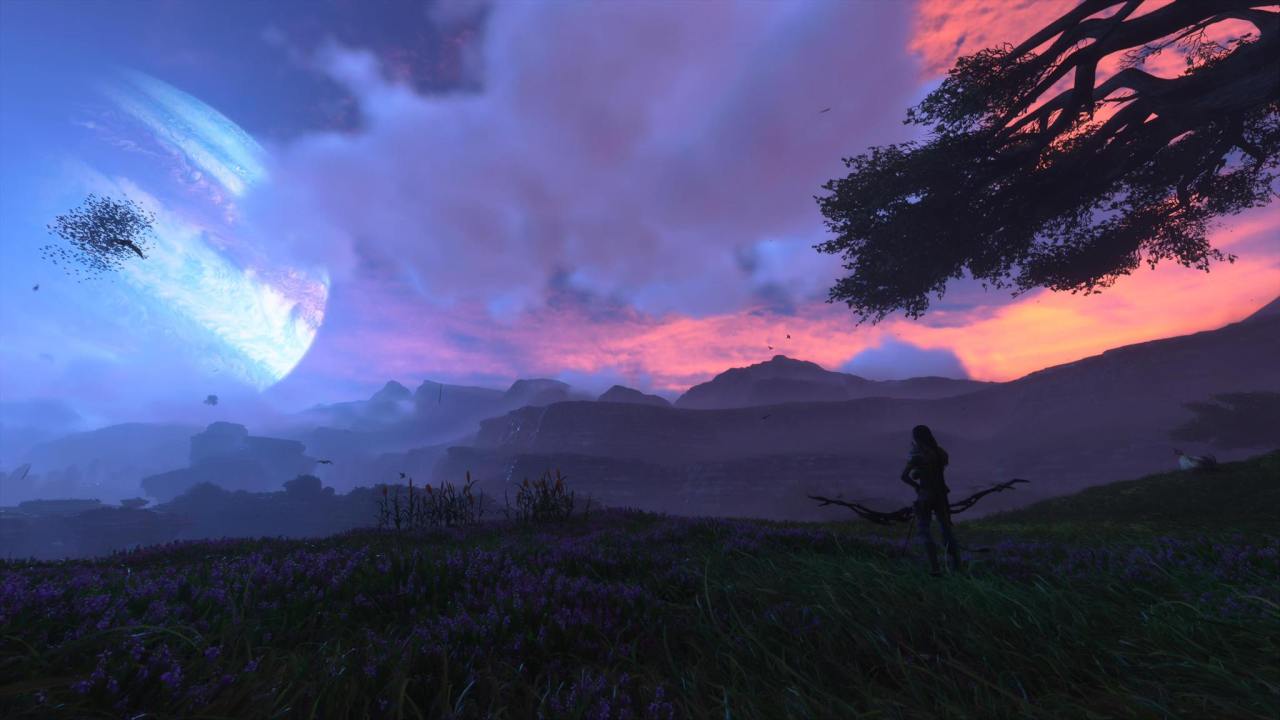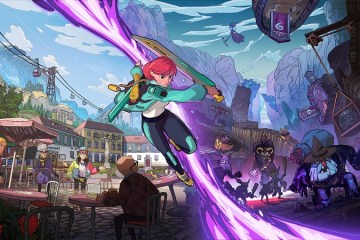Ask me what the plot is for James Cameron’s 2009 financial smash hit Avatar and its equally successful 2022 sequel Avatar: The Way of Water, and I basically come up empty handed without looking at Wikipedia. Other than a vague recollection of the first movie being so similar to something like the plot for Pocahontas and the second movie being about deserter Jake Sully and his family surviving an attack from a clone from the first film’s villain, it was not a movie series that lingered in my mind. But if there was something I do remember from my experience watching those visually arresting movies, it was saying “this could make a kick-ass video game.”

Back in 2009, Ubisoft and their Ubisoft Montreal team took a first crack at delivering a game set in this lush world with James Cameron’s Avatar: The Game, a well-intentioned third-person shooter that allowed you to pick sides between the human soldier faction RDA and the native blue people, called the Na’vi, that looked great but fell way short of its potential. Now, 13 years later, Ubisoft gets the chance to take a second crack at the franchise with The Division developer Massive Entertainment, translating James Cameron’s sci-fi epic into their traditional open world formula based on their perennial Far Cry franchise to deliver a game that more closely brings this world to life in video game form than the last attempt.
While not without its stumbles when it comes to system depth and player progression, Avatar: Frontiers of Pandora breathes some new life to Ubisoft’s tried and true open world formula, showing a developer that has heard a lot of the feedback that’s ailed a lot of their recent big open world games and working ways to correct what ails it, all while delivering one of their most visually arresting worlds to get lost in.
Don’t Mess With The NA’VI
Set in a 16 year period that starts 8 years before the 2009 film which then intersects with the end of that first film and the middle year gaps leading to The Way of Water, Avatar: Frontiers of Pandora centers around five Na’vi children (one of which is your playable character creation) who were kidnapped early on to serve on the RDA’s “Ambassador” program of Na’vi indoctrination. After the actions of movie hero Jake Sully send most of the RDA packing, these five children escape extermination by hiding in cryo sleep to wake up years later to be released to the outside world of Pandora. As the RDA makes their slow return to Pandora to extract the planet’s resources, it’s up to the children to connect with the different Na’vi clans to push back against the RDA’s slow deterioration of Pandora and prevent the lush planet from succumbing to a completely uninhabitable state.

This is the main plot which drives your entire actions through Avatar: Frontiers of Pandora. With very few exceptions, the plot doesn’t really develop anything resembling a true emotional connection beyond the superficial plot drive. Similar to the problems I have with the movies, the game’s overreliance of the main Na’vi people, which all have very similar looks and names, makes it hard to distinguish the different characters. So when dramatic moments end up happening, I have already forgotten if the characters were of any meaningful importance because I don’t remember if it’s the cast I met early in the game or those in the various settlements. While some of the side quests help flesh out the individual elements of this lush world, beyond the visual spectacle, it was hard not to just go through the motions of the main story all the way to its conclusion.

But if the story is nothing to really write home about, the experience of living in this world is definitely one of note. Just like I imagined it would be when I experienced the movies, the world of Pandora was perfectly ripe for an exploration-style open world game of this sort. There are no two ways around it: Avatar: Frontiers of Pandora is the next Far Cry game from Ubisoft in everything but name. So you know what to expect: a lush, massive open world with tons of points of interest, animals to hunt, weapons to collect, bases and outposts to clear, and missions and side missions to accomplish. While the formula is certainly a familiar one, the ways Ubisoft has tried to evolve the formula are definitely welcome, even if some additions and alterations may be slightly questionable.
A NA’VI Deal

While the game definitely fits the checklist nature of Ubisoft’s open world formula, it’s clear the company has taken note of all the recent feedback that has become meme worthy regarding how their most recent epic open world games were an endless clutter of icons in the world, with a very busy/noisy UI to present it all in a way that felt very exhausting. Perhaps through happenstance with how people have flocked more to recent open world games that trust the player a little more in their own discovery, Avatar: Frontiers of Pandora definitely tries to hit a middle ground on pushing more for observation and exploration to guide yourself through the environment (especially if you choose the “exploration mode” instead of “guided mode”) instead of always outright telling you where to go.
Na’vi vision, used by holding the R1/RB button, is this game’s version of the “eagle vision” you see in Ubisoft’s Assassin’s Creed franchise that de-colors and highlights some things you look at in your world. The only difference here is that it just highlights a big circle in the middle of your HUD, so you still have to look around to see points of interest in your environment. While, sometimes, environments can feel a little too cluttered where the system may seem like it’s not highlighting things as they should, more often than not, it’s a system that works as intended. In a way, instead of spoon feeding the information, you gotta work a bit more to find it, which I found slightly more immersive than Ubisoft’s usual navigation.

It’s not just the Na’vi vision that helps with immersion. Continuing the trend of recent Ubisoft open worlds moving slightly away from the “climb tower, synchronize” trope of map unlocking, Avatar: Frontiers of Pandora definitely takes inspiration from the Ghost of Tsushima playbook of using “fog of war” that slowly opens up as you naturally explore Pandora. While there are ways to eliminate the fog of war faster by clearing drill stations and RDA bases, finding those are not clearly marked on a map. It’s through clever observation of how the flora of Pandora is deteriorated in certain spots that tends to lead you to where you’ll find the RDA drill or outpost to take care of, which both restore the lush look of Pandora in specific regions while clearing a portion of the map for you. This works even better once you unlock your flying mount, as naturally seeing the places from high up in the sky makes clearing the map a more fun proposition than it was in the recent Far Cry games from Ubisoft.

It’s these little details that make the tried and true Far Cry formula feel slightly fresh in Avatar: Frontiers of Pandora while also making it feel congruent with James Cameron’s world. While at first glance, it may seem like Ubisoft just took Far Cry: Primal and put it on Pandora, there is a little bit more to it that still feels like a meatier version of that paired-back formula. While a lot of the game definitely pushes the use of bows, spears, and slingshots quite heavily, the game also allows the use of limited weaponry like an assault rifle, a shotgun, and a rocket launcher, which you can pick up during the RDA station clearings. The shotgun, in particular, is so overpowered, it feels good to shred the RDA’s mechs that can be a real pain in the ass to fight.
While there is a certain satisfaction with some of the tools you are given, I can’t stress this enough: your Na’vi is more nimble than a palm tree when it comes to taking hits before dying. Early on, you feel almost obscenely weak when fighting against enemies, and while, eventually, a mix of the skill tree and some plants you find in the world increase your health resistance to withstand some damage, the nimbleness of your character may slightly push you towards a stealthier approach for better success.
There is some truth to that, and it can be quite satisfying to pull off an entire RDA station or drilling checkpoint in a quiet matter, but the enemy distribution of these sections, along with some inconsistency with vision cones and the rules of engagement, almost makes it feel like it’s impossible to pull everything off in a stealthy manner. While further upgrades you find can do increased damage to enemy weak spots, even unlocking a visual that projects an enemy’s walking pattern, there are times where enemies may spot you when there is no logical way that they should, bringing to mind some of the inconsistent stealth from Assassin’s Creed: Valhalla. It will eventually lead to some trial and error if you are attempting a complete stealth approach when clearing the big bases. Though bases can certainly be satisfying to clear all guns blazing (especially with a coop partner), doing it via stealth is still encouraged because clearing them without triggering an alarm can give you double the rewards. And you certainly may want those double rewards, considering the progression system in place.

There are certain elements in Avatar: Frontiers of Pandora that feel like an improvement of the Far Cry formula, but there are a few that I feel are either side steps or slight step backwards. Level progression, hunting, and crafting are certainly staples of the Far Cry formula, particularly the latter where you can build yourself better utility items to improve your gameplay. But in Avatar: Frontiers of Pandora, these elements are not optional; they are actually vital for progression, here. This game continues this weird trend in Ubisoft games where they love level gating progression, even when the game is not a complete RPG experience. To progress through the main story in this game, you have to be at least one level beneath the recommended level or you risk getting shredded. But in order to increase your level, there is no traditional XP meter to level yourself up. Leveling up is mostly tied to the rarity of your equipped armor and weapons, with tiny gains made by the unlocking of your skill tree, with skill points found either through certain plants you find in the world or through the completion of main quests and side quests.
To make the most gains in level to keep up with the requirements, you have to improve your gear. Sometimes, you find weapons or armor pieces that pump you up in the main missions if you explore them thoroughly. Or if you do a complete “non-alarm raised” RDA outpost where you get double loot. Or if you engage in the game’s hunting and crafting or buy some gear from specific vendors in your Resistance base. The way I played Avatar: Frontiers of Pandora, I definitely prioritized just exploring the world and doing the RDA outposts in a stealthy manner, and that allowed me to have enough gear to stay at least two levels above the required level. But that required me to explore the massive world to do that. If you are looking into just mainlining the game, based only on what is given to you, it doesn’t seem like it would be possible without engaging with the other systems in place. Just doing side quests alone, which at times only give you one skill point for skills that require 3 to 4 to unlock, is not the right path for success.

The hunting and crafting system, on paper, sounds like a good idea to circumvent and target what you need to level up and, in theory, allows you to immerse yourself more in the world. But even then there are slight complications to that system. For one, the game tries to add survival elements to its underlying systems, which means hunting animals also requires filling up your satchel with food to keep you and your flying mount’s stamina up for maximum effectiveness. Without targeting the skill points that slightly increase your sachet size, you encumber your resources fairly quickly, which can be annoying. There are also a the litany of different resources with different rarity that are required to create the most optimal gear to level you up properly, and they are tied to an RNG system based sometimes on time of day where some resources sprout during random dry or wet weather or if it’s light or dark (or if you pull them out properly with a trigger-based mini-game).
As for animals with the highest rarity, they can be found in very specific areas and biomes in the map, and you’ll know where they are once you really unlock the fog of war. And the animals need to be killed in specific ways, such as by targeting the weakspots or killing them with the least amount of shots possible, to get the most optimal pieces from them. It just adds extra busy work to the proceedings, and the only times I engaged in that crafting system was just by happenstance of randomly having what I needed for a specific piece that leveled me up just right. I’m happy there are other avenues to keep up with the level grind, but considering crafting and hunting is the one way to make it more specific, I can imagine this could be a turn off for those who just want to see the game through instead of wanting to live and breathe the world of Pandora where it could come more naturally.
I Can’t NA’VI Leave It

And what a world this Pandora is, I tell you. If there is one area where Avatar: Frontiers of Pandora is an unequivocal win, it is just how perfectly this serene, otherworldly alien jungle is realized as a playable space. You can see the screenshots attached: this is an absolutely marvelously beautiful world to just explore and get lost with. The mix of beautiful vistas and colors are such that the game takes every advantage it can to showcase its beauty. Just as I expected when I had that desire watching the movies, Pandora is perfect for a videogame, and the world certainly kept me hooked even when the less-than-compelling story and the less desirable gameplay systems would sometimes butt in on my enjoyment. It certainly kept me engaged as a place to just exist in more than the last couple of Far Cry games.
As Ubisoft’s first official game made exclusive to the newer batch of consoles and PC, Avatar: Frontiers of Pandora definitely proves their proprietary Snowdrop engine is capable of standing toe to toe with the best tech currently in the industry. Playing the PlayStation 5 version, I played the game on the included performance mode. Barring a few moments of slowdown during heavy smoke particle effects and some image dithering as a clear symptom of the game’s image reconstruction techniques, the game performed mostly admirably considering the complexity of the lush world rendered around you. The pop in color and lighting, especially at night, definitely never stopped being a feast for the eyes.
The game also performs fairly well in the quality mode, with an option to enable motion blur to eliminate judder that keeps the game performing well and looking even more gorgeous. Because the game is an FPS at heart, the performance mode was still worth taking the visual hit as it still was a beautiful enough game on offer, and the improvements of combat at the faster frame rate were definitely worth it.
If there is only one thing that didn’t pass the visual muster for me, it was the quality of the facial animations. Considering the high standard set elsewhere, the faces of both the humans and the Na’vi didn’t quite match the quality of the rest of the visuals. But despite that, it’s certainly a game carried aplomb by its visual punch.

As for the game’s technical stability, so far Ubisoft continues their recent trend to offer a more stable product at launch than usual (this year’s Assassin’s Creed: Mirage was also fairly polished). It’s certainly the most polished out of Massive’s games so far, with the only real glitches being some lighting flickering happening in some of the open terrains of the upper map at random times, along with a truly bizarre bug in one of the later chapters in the game where enemy bullets were penetrating the walls in a way that didn’t make sense, making that sequence a stealth nightmare. Thankfully, a console reset fixed that unfortunate mishap. And even after close to 50 hours of playtime, the game didn’t crash a single time in my experience. Considering that Ubisoft announced that this game was in development at Massive almost 6 years ago, it definitely feels like the time spent on it did create a more stable product for them, which is mostly welcome.
At the end of the day, despite some flaws, I definitely enjoyed my time with Avatar: Frontiers of Pandora. While the story didn’t quite hook me, the same can be said about the movies. To me, this franchise is more about the beautiful realization of its world and its visual spectacle, and, in many ways, Avatar: Frontiers of Pandora hit the marks I wanted it to hit. I appreciate the ways Ubisoft is slowly tweaking their open world approach into something that continues to be more diegetic instead of just a checklist to do, allowing me to be more immersed in the world as a result. While I was not as enthralled with the ways progression was tied to its more survival-tinged mechanics, when I was flying around this beautifully realized world taking it all in, those annoyances would fade in my mind.
Even if you are not a big fan of the Avatar property, if you have enjoyed Far Cry in the past and are curious to see how Ubisoft is slowly evolving their tried and true formula, or if you just want a beautiful place to get lost in, Avatar: Frontiers of Pandora definitely fits the bill. Considering how copied the Far Cry formula has been by many open world competitors, this is certainly the most I’ve enjoyed it out of Ubisoft in some time.
Thank you to Ubisoft for providing the review code of Avatar. You can find Seasoned Gaming’s review policy here.


